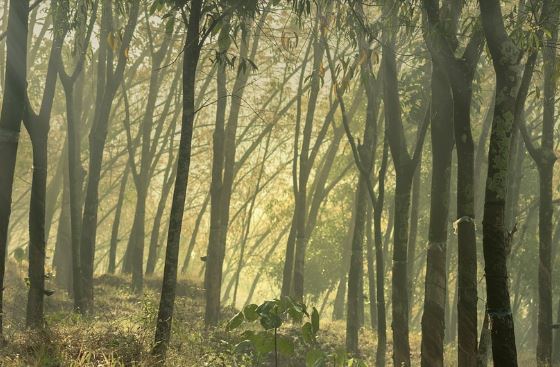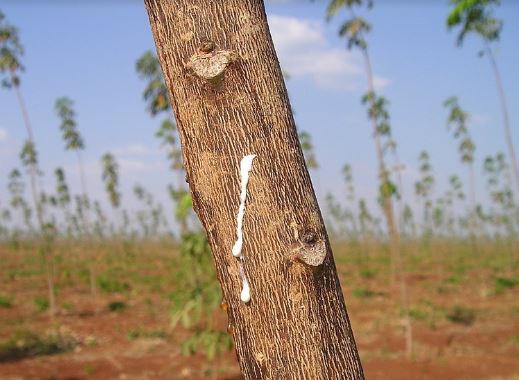
The rubber tree could be the ideal houseplant for you if you want a tough but easy-going indoor plant that can reach staggering heights within just a few years.
Although young plants begin small, they will quickly fill the space in an empty corner thanks to their shiny, glossy leaves, a full-grown rubber tree look great in most homes despite its size.
Table of Contents
Rubber Tree Overview
Because their sap is occasionally used to make rubber, rubber tree got their name. The leaves of the rubber plant also have a shiny, rubbery appearance. If you give these plants the right care, they will develop gorgeous leaves and grow tall.
Though they also come in more vibrant varieties, rubber plants are typically seen in their dark green variety. For example, varieties known as the “black prince” or “burgundy” have reddish-black leaves.
Propagation
A healthy rubber tree is usually ridiculously simple to grow more of.
As was already mentioned, this plant grows so prolifically that it occasionally only needs to be pruned and replanted, rooting as it pleases.
To give the plant the best chance of adjusting to the conditions inside your home, it is best to start with a young plant.
Put on a pair of gloves before handling cuttings or piercing the tree’s bark to protect your skin and avoid coming into contact with the sap, which is known to irritate some people.
To avoid spreading a disease or harming the plant, make sure any tools you use, like a knife or pair of pruning shears, are clean and sharp.
To prevent stains on your furniture and work surfaces, move the plant outside or place it on a protective surface like a potting mat or tarp. You’ll also want to keep a rag on hand to collect the latex sap.
Grow
The robust, low-maintenance rubber tree can withstand significant neglect. It requires little water during the winter because of its large, waxy leaves, which are excellent at retaining moisture.
The plant will grow the most in the spring and summer, during which time it will require more water and light.
Keep it away from the sun’s direct rays. More sun, however, might help if you see the plant is lanky or the leaves are wilting or discolored.
A rubber tree should not be overwatered, so be careful. Too much water can result in root rot, dropping or drooping leaves, and poor growth.
If necessary, add liquid fertilizer for tropical plants in the spring or summer as directed on the container.
Check to make sure the roots of the rubber tree are not engulfing its container as it grows.
Roots that are growing at the soil surface may branch and curl to the edge of the pot in a process known as girdling, and you may notice some discoloration of foliage or leaf drop.

You might also be able to see visible roots that have gotten compacted there if the pot has lots of drainage holes.
Removing the plant from the pot allows you to see if the roots have grown bound or constricted in the shape of the pot, which is one indication that the spacing is correct.
It’s time to report the rubber tree if the roots appear to be occupying the majority of the available space.
Select a container that is a half-inch to an inch bigger than the previous pot.
Place a layer of the same soil, moss, or coir mixture at the bottom, leaving room for the plant’s root system so that the top of the roots will be close to the rim’s level.
The girdled roots can be slightly separated by applying gentle downward pressure with your fingers starting from the bottom up.
Trim away any decaying or dead roots you come across while doing this.
Put the plant in the fresh pot, then add soil to the sides. Water well to settle.
Whether or not the roots have become tangled, it’s a good idea to repot the plant every few years as this will keep it well-fed and nourished.
Every one to two years, the top few inches of soil can be removed and replaced with fresh soil or compost to replenish the pot’s nutrients.
Due to their size, this rubber tree’s leaves are crucial in preserving moisture levels.
Plant health can be enhanced by increasing humidity to more closely resemble the native tropical environment from which these trees came.
To accomplish this, mist the leaves several times each month, especially in the winter when indoor heating can result in dry air.
You may decide to wipe the leaves with a damp cloth instead of misting them because misting can be messy. By supplying more moisture, leaves can remain glossy and healthy while also maintaining moisture levels.
Additionally, now is a good time to clean off any dust that has accumulated on the leaves and prune out any foliage that is dead or dying.
If the outside temperature is consistently above 50°F, container-grown rubber trees can be relocated outside.
Place the tree in a protected area, and once more, keep it out of direct sunlight.
Rubber trees can also be grown outdoors in USDA Hardiness Zones 9-11 year-round.
Remember that the tree may grow quickly if you plan to plant it in these zones directly in the ground.
Keeping that growth under control is crucial to preventing it from spreading and interfering with the local ecosystems and native vegetation.
Some outdoor specimens in subtropical and tropical climates can grow more than two feet per year and have been measured at over 100 feet in height with a sprawling habit.
They may also supplant nearby plants.
Place the rubber tree in a location with good drainage, enough water, and indirect sunlight. Because of their powerful roots, rubber trees should not be planted close to sidewalks or foundations.
Rubber Tree Care Tips
Balance is the secret to proper care for rubber plants. It enjoys the right amount of water and sunlight. You can have a content, robust, and tall rubber tree if you can give it the ideal ratio of both. If you notice that rubber plants are losing their lower leaves, this is a sign that they either need more sunlight or water. Continue reading to find out how to care for your rubber plant in the best possible circumstances.
Light
Rubber trees prefer moderately heated, bright, indirect light. Leaf scorching can occur when exposed to direct sunlight. For the ideal amount of sunlight, keep your rubber plant close to a window with a sheer curtain. Make sure to provide extra bright light for the more iridescent varieties because they require more light to help bring out their colors.
Water
In the summer, when the rubber tree is growing, they need more water. Ideally, the soil should be kept damp but not soggy. In order to keep the leaves moist and to help your plant absorb more sunlight, you should also wipe them down with a damp cloth. If you don’t want to wipe every leaf, misting is an additional option. As a preventative measure against root rot, always keep your rubber plant in well-draining soil.
You want to keep the soil dry during the winter when plants are dormant, but not too dry. In order to avoid overwatering, allow the top few inches of soil to completely dry between waterings. Your rubber plant is communicating with you that it needs more water if the leaves begin to droop.
Temperatures
Generally speaking, rubber tree prefers temperatures between 60°F and 75°F. They can endure temperatures as low as 50°F during the winter. A healthy temperature balance is ideal for this plant’s growth, just as it is with its requirements for water and sunlight. Due to its tropical origin, it prefers humid, moist air, though it can endure dry conditions. Because they are sensitive to temperature variations, rubber plants favor environments with stable humidity and temperatures.
Toxicity
Some people may experience skin irritation from the sap of rubber trees. After handling your plant, make sure to thoroughly wash your hands, especially if you came in contact with the sap. Depending on how much is consumed, eating this plant can result in minor stomach discomfort or more serious symptoms like diarrhea or vomiting.
Pests
Among the bugs that frequently make your rubber trees their home are mealy bugs, mites, scales, and aphids. If discovered early enough, you can get rid of these insects by wiping them down with an insecticidal soap solution or warm water and soap.
Problems
It’s simple to make your rubber tree unhappy if you stop attending to its needs due to its requirement for balance in all forms. The best way to avoid this is to monitor the amount of light it receives, the amount of moisture in its soil, and the room’s overall temperature.
The majority of plant diseases linked to overwatering most commonly affect rubber plants. To prevent drowning your plant, as we previously mentioned, you should let the soil get completely dry in between waterings.
If you need any additional advice for dealing with any of these rubber plant issues, look at our guide to reviving a plant.
Repotting
Your rubber tree needs to be repotted if you want it to grow. According to the size of your pot and how quickly your rubber plant grows, you might need to do this every few years or every year. If you want to keep your rubber plant at its current size, don’t report it.
Pruning
To help your rubber plant support itself, encourage new growth, and keep it from getting too big, you’ll need to prune it. A rubber plant can be pruned at any time of the year, though spring is the ideal time to do so and winter should be avoided. Be aware that pruning the branches will cause some sap to leak out.
Now have your own rubber tree after reading this article and try it.